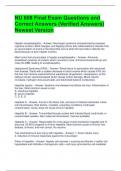NU 608 Final Exam Questions and
Correct Answers (Verified Answers)
Newest Version
Hepatic encephalopathy: - Answer- Neurologic syndrome characterized by impaired
cognitive function, EEG changes, and flapping tremor also called asterixis. Results from
an accumulation of toxins in the blood that occurs when the liver fails to detoxify the
blood because of poor hepatic function.
Main toxins that accumulates in hepatic encephalopathy: - Answer- Ammonia
(breakdown products of protein) which converts to urea. Ammonia levels build up and
cross the BBB, leading to encephalopathy.
Hepatorenal Syndrome (HRS): - Answer- Renal failure in association with advanced
liver disease. Starts with a sudden decrease in blood volume which causes ATN, but
the liver cant remove vasoconstrictive substances (angiotensin, vasopressin), so the
kidneys remain vasocompressed which causes further damage. Blood volume
increases, hydrogen ions accumulate, and electrolyte balance is disturbed.
Hepatitis (types): - Answer- Systemic viral disease that affects the liver. Inflammation of
the liver. Most common cause is viral.
A- infectious hepatitis
B- serum hepatitis
C, D, E, G
Hepatitis A: - Answer- Found in the feces, bile, and sera of infected individuals. Fecal-
oral transmission. Risk factors- crowded, unsanitary conditions, food/water
contamination. Acute, does not cause chronic hepatitis.
Hepatitis B: - Answer- Transmitted through contact with infected blood, body fluids, or
contaminated needles. Also maternal transmission. Vaccine available.
Hepatitis C: - Answer- Responsible for most cases of post-transfusion hepatitis and IV
drug use. 50-80% progress to chronic hepatitis. Most common cause of chronic liver
disease, cirrhosis, and liver cancer. No vaccine.
Two mechanisms of liver injury with hepatitis: - Answer- 1. direct cellular injury
2. induction of immune responses against the viral antigen
Patho of hepatitis: - Answer- Hepatic cell necrosis = scarring and fibrosis = kupffer cell
hyperplasia and infiltration of phagocytic cells = cell injury promoted by cell-mediated
, immunity = regeneration of hepatic cells = inflammatory process = obstructive jaundice,
cholestasis, bile duct obstruction.
Acute Hepatitis phases (4): - Answer- 1. incubation period
2. prodromal- 2 weeks after exposure and ends with appearance of jaundice. Fatigue,
nausea, fever, RUQ pain, weight loss, AST/ALT elevated.
3. icteric- 1-2 after prodromal, jaundice, dark urine, liver enlargement, prolonged PTT.
4. recovery phase- resolution of jaundice, symptoms diminish, LFTs return to normal.
Chronic Hepatitis: - Answer- abnormal LFTs for 6 months, symptoms persist.
Fulminant hepatitis: - Answer- Clinical syndrome resulting in severe impairment or
necrosis of liver cells, potential for liver failure, usually seen in hep C and hep B,
develops 6-8 weeks after initial symptoms, hepatic necrosis is irreversible, liver
transplant needed.
Cirrhosis: - Answer- Irreversible inflammatory disease that disrupts liver function and
structure leading to decreased hepatic function as a result of nodular and fibrotic tissue
synthesis. Biliary channels become obstructed and cause portal hypertension. Blood
gets shunted away from the liver and a hypoxic necrosis develops. Ascites is a late
stage manifestation.
Causes of cirrhosis: - Answer- 1. alcoholic- starts with fatty infiltration of the liver
2. biliary- damage begins in the bile canalculi and ducts
3. post-necrotic- result of severe liver disease
Hormones: - Answer- Chemical messengers exerting action on specific target cells.
Classified according to structure. Amino acids, peptides, steriods, fatty acid derivatives.
Characteristics of hormones: - Answer- Each type has specific rates and rhythms of
secretions, affect only cells with appropriate receptors, operate within a feedback
system. Liver metabolizes hormones.
Hormone transport: - Answer- Released into the circulatory system by the endocrine
glands.
Water-soluble hormones circulate in free, unbound forms (insulin).
Lipid soluble hormones circulate bound to a carrier (cortisol, thyroid). When circulating
around the body, only target cells are affected.
Hypothalamic-pituitary axis: - Answer- Hypothalamus (part of the brain wehre the
activity of the ANS and endocrine glands are integrated) and pituitary gland (responds
to input from the hypothalamus) meets.
Two major posterior pituitary hormones: - Answer- 1. vasopressin (ADH) controls
plasma osmolality
2. oxytocin promotes uterine contractions and lactation




